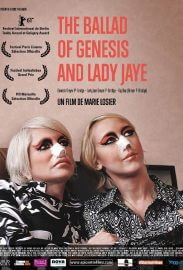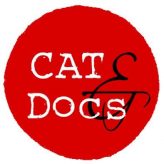
https://www.filmplatform.net/product/ballad-genesis-lady-jaye
Genesis Breyer P-Orridge has been a key figure of the underground music scene for over 30 years. A cult artist in prepunk and post-punk groups , he is considered to be the father of industrial music and a pioneer of acid house and techno. Genesis has also used his position at the limits of society to challenge the very fundamentals of biology.
Transformation is, indeed, central to his life. He became a she to resemble his beloved Lady Jaye, now deceased. With peroxide hair, full lips and gold teeth, Genesis does not go unnoticed.

A Love Story
“My project is not about gender. Some feel like a man trapped in a woman’s body, others like a woman trapped in a man’s body. The pandrogyne says, I just feel trapped in a body. The body is simply the suitcase that carries us around. Pandrogyny is all about the mind, consciousness.”
– Genesis Breyer P-Orridge
Both Genesis and Lady Jaye were born with life changing illnesses, imprinting upon them from an early age an incredibly complex relationship to their bodies. Later in life, they became gender variant activists, their mutating appearance based on gestural aesthetics, a living project documented through their collaborative paintings, photographs, writings and performances. With Lady Jaye’s death, as a way to honor his lost love, Genesis remains committed to his quest for the Pandrogyne.
It was in 2003 that Genesis changed his name to Genesis Breyer P-Orridge, beginning a performance series called ‘Breaking Sex’. This project was about reunion and resolution of male and female to a perfecting hermaphroditic state through cosmetic surgery, blurring the line between the sexes, bringing Genesis and Lady Jaye nearer to one physically.
The passing of Lady Jaye has become central to my film. I thought this tragic event would prevent me from continuing to shoot, but I was surprised to find Genesis wanting to continue. In his mind, the completion of this film would be the most appropriate way to honor his love and life with Jaye, a message of hope and solidarity with artists and lovers everywhere, regardless of gender or sexual orientation. By allowing me unprecedented access over these past many years to film their professional and personal lives, I believe I have material that transcends most fiction films, but whose message is ultimately grounded in the most humanistic and basic of desires: the affirmation of love.
Director’s Statement
Much of the film has been shot using a silent Bolex 16mm film camera. Since I primarily shoot alone, the Bolex has become a vital part of my body, almost like an extra hand, a very human camera allowing me to communicate what I need to visually while liberating me completely from any fears during shooting. Being somewhat small and acrobatic, a dynamic relationship often develops between me and my subjects yielding beautiful, improvisatory, motion photography. In addition, I have employed state of the art HD video technology to capture numerous interviews and performances with Genesis allowing me exclusive access to his private film and media archive, literally hundreds of hours of found footage collected over many years, news clips and home movies (some dating back several decades and never before seen publicly).
I envision the film as an agile, mobile, playful, hand-spliced patchwork of iconic images, one which captures the constant activity, flow and theatricality of the lives of Genesis and Lady Jaye. Second cameraman Benjamin Kasulke brings with him a completely original aesthetic. Having recently shot Guy Maddin’s Brand Upon the Brain, a film whose surreal, perfectly crafted, black and white cinematography bristles with an intuitive sense of movement, Kasulke’s mastery of magical Melies-esque superimpositions will be used to illustrate the Pandrogeny process.
Woven from stories, memories, dreams, music and interviews, several portions of the film have been shot in a studio employing elaborate costumes and choreography to dramatize key moments in the lives of Genesis and Lady Jaye.
I approach my subjects as if it were the beginning age of cinema, the time of George Melies and the Lumiere Brothers, by creating tableau vivants- comical, colorful, mise-en-scene recreating stories and interviews. By re-enacting scenes from their own lives, what begins to emerge is a truth that far exceeds the conventions of traditional documentary filmmaking. By approaching my subjects from oblique angles, my editing style functions like a colorful, incongruent, tapestry; small details offering a more acute sense of the whole.
The film will attempt to present the incredible complexity of Genesis’ personality from many different angles, most especially my subjective point of view. From my earliest films, my feeling has been that when shooting real life subjects, my very presence changes the reality of what I am filming. Therefore, I am not a neutral participant, but one equally engaged and inspired by what is happening in front of my camera. I chose to capture the essence of my subjects from a multiplicity of angles, pulling back different layers of reality in an effort to reveal something unexpected. This is why, for me, fiction and fantasy have become integral parts of what I do. As a filmmaking practice, it is a form of psychodrama allowing my subjects to step outside of themselves and fixed habits of mind. What often happens is that hidden or unknown parts of their personality begin to emerge; through the veil of fiction one begins to understand a person’s fantasy life, their secret wishes and desires, their most powerful feelings about the world and their place in it.
In one sequence, I filmed Genesis speaking about how he writes music in a beautiful bird costume I made for him. His words and gestures are translated into images as he whistles his music and talks about how he creates certain sounds. The whole scene becomes magical, he acts out his music, the costume amplifying a humorous, freer, aspect of Genesis’s personality few have ever had a chance to see. In another scene, I built a set for him to reenact how he first met Lady Jaye. It is an incredible moving scene that poetically and visually expresses the stages of his love for Lady Jaye.
I have 4 hours of 16mm footage and 30 hours of interviews on HD video. I shot the staged and fictional elements with my Bolex 16mm giving this material a more cinematic, oeneiric, feel. I intend to weave this footage with the interviews and scenes from Genesis’s daily life shot in HD, a format more traditionally associated with modern documentary filmmaking. Conforming and transferring the 16mm footage to HD, the film will be edited on Final Cut Pro, for a final feature length film rendered in high definition for transfer to 35mm.
Music is the primary way Genesis has made his living and will be an integral part of the film helping to shape its narrative and rhythm. Genesis has generously allowed me to use his music which will be combined with recordings of interviews, concerts and rehearsals, taped over several years and in many different formats including reel to reel, camera recordings and open microphone. I will be working with an engineer to mix and conform the sound so I can seamlessly blend the soundtrack over the images. Working with Brion Dall, a trusted collaborator of Genesis who mixed all of Psychic TV albums, his knowledge and care for this material will be of great benefit in composing a complex, other worldly, soundtrack employing speech, music and found sounds.
For 4 years I have been filming incredible stories from Genesis’s close friends, including musicians, writers, and filmmakers Orlan, Jim Jarmusch, Tony Oursler, Peaches and Chris Christerpherson. I have many interviews still planned including Jenny Schlenzka, Film Curator at MoMA (NYC), where Genesis will be delivering a talk about her career in March 2010, and an interview with Caresse, Genesis’s daughter living in Turkey, confirmed for next year pending additional funds that might help bring her to NYC.